Multi-factor Authentication Market Size and Forecast 2025 to 2034
The global multi-factor authentication market size surpassed USD 16.85 billion in 2024 and is expected to hit around USD 83.72 billion by 2034, poised to grow at a CAGR of 17.39% from 2025 to 2034. The market growth is attributed to the increasing adoption of advanced technologies and solutions that enhance efficiency, security, and user experience across various industries.
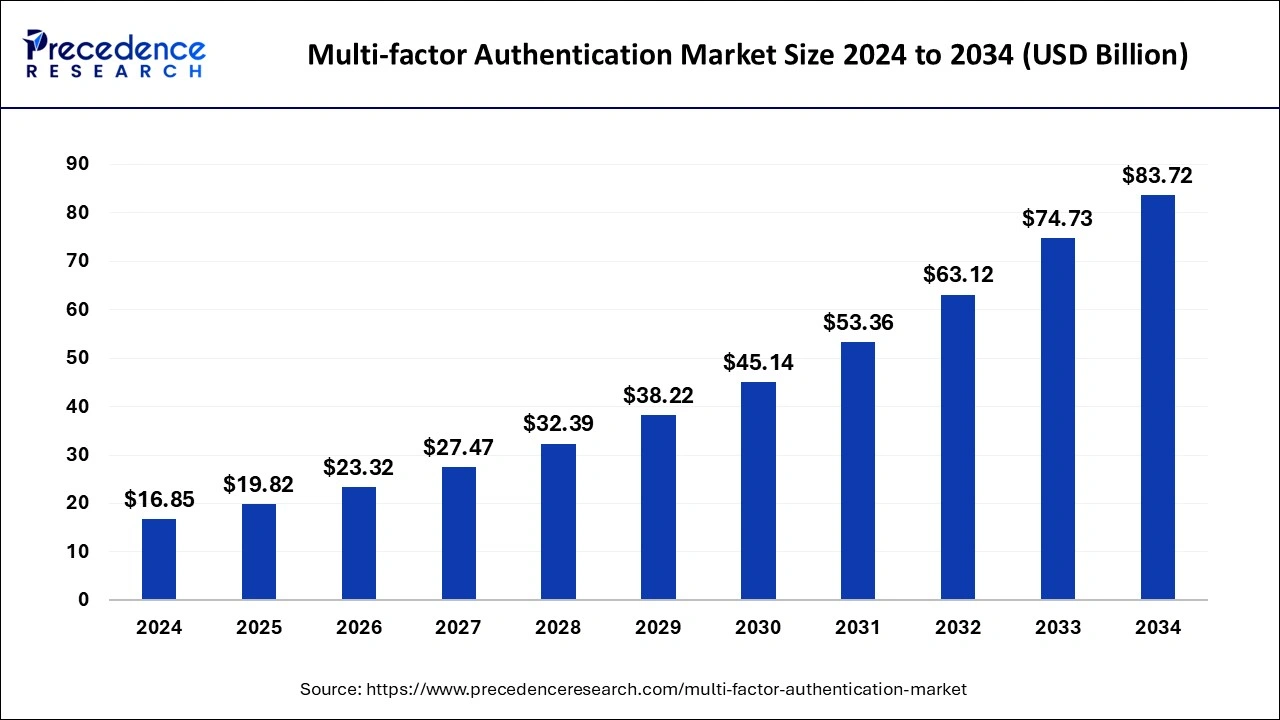
Multi-factor Authentication Market Key Takeaways
- The global multi-factor authentication market was valued at USD 16.85 billion in 2024.
- It is projected to reach USD 83.72 billion by 2034.
- The multi-factor authentication market is expected to grow at a CAGR of 17.39% from 2025 to 2034.
- Asia-Pacific contributed more than 40% of market share in 2024.
- North America is estimated to expand at the fastest CAGR between 2025 and 2034.
- By authentication type, the password authentication segment held the largest market in 2024.
- By authentication type, the password-less authentication segment is anticipated to grow at a remarkable CAGR between 2025 and 2034.
- By model type, the multi-factor with three-factor authentication segment generated largest market share in 2024.
- By model type, the multi-factor with four-factor authentication segment is expected to expand at the fastest CAGR over the projected period.
- By component, the hardware segment generated over 45% of the market share in 2024.
- By component, the services segment is expected to expand at the fastest CAGR over the projected period.
- By end user, the commercial security segment generated over 26% of the market share in 2024.
- By end user, the telecommunication segment is expected to expand at the fastest CAGR over the projected period.
Impact of Artificial Intelligence on the Multi-factor Authentication Market
AI plays a major role in expanding the use of multi-factor authentication methods across organizations and reshaping the overall approach to digital protection. AI improves the authentication processes by providing options, including adaptive authentication, risk scores in real-time, and behavioral analytics. These capabilities enable the systems to adapt and detect threats for security, hence providing powerful protection against advanced forms of cyber threats. Additionally, AI algorithms eliminate unnecessary obstacles when getting through the verification procedures without compromising security.
Asia Pacific Multi-factor Authentication Market Size and Growth 2025 to 2034
The Asia Pacific multi-factor authentication market size was valued at USD 6.74 billion in 2024 and is expected to reach around USD 33.91 billion by 2034, poised to grow at a CAGR of 17.53% from 2025 to 2034.
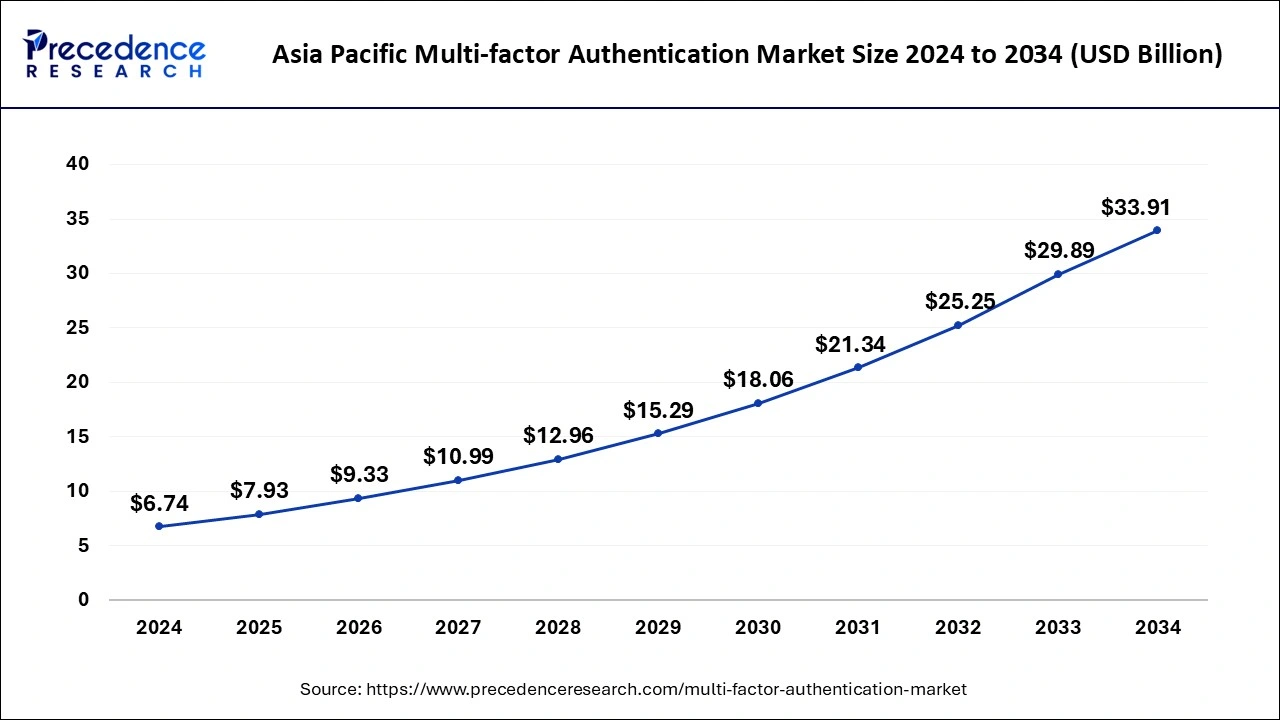
In 2024, Asia-Pacific held a share of 40% in the multi-factor authentication market due to several factors. Rising cyber security concerns, increased adoption of digital technologies, and a surge in online transactions drive the demand for robust security measures. Additionally, the region's expanding IT infrastructure and government initiatives promoting digital security contribute to this growth. As businesses and individuals prioritize data protection, the Asia-Pacific multi-factor authentication market is expected to flourish, offering advanced solutions to mitigate the evolving threat landscape effectively.
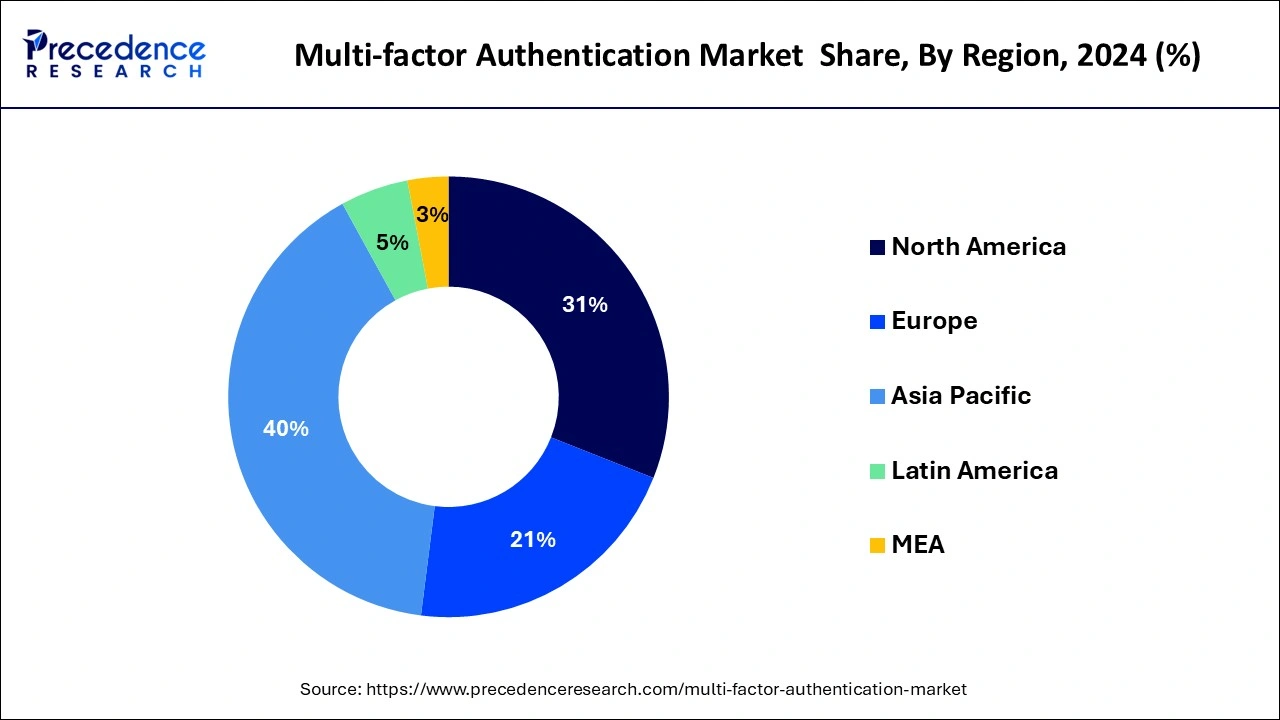
North America is poised for rapid growth in the multi-factor authentication (MFA) market due to a combination of factors. The region faces escalating cyber threats, driving increased demand for robust security solutions. Stricter regulatory requirements, such as those outlined in GDPR and HIPAA, are pushing organizations to adopt MFA for compliance. Additionally, the widespread adoption of cloud services and the shift to remote work further amplify the need for enhanced authentication measures. This convergence of factors positions North America as a key market for MFA growth in the face of evolving cybersecurity challenges.
Meanwhile, Europe is witnessing notable growth in the multi-factor authentication market due to stringent data protection regulations like GDPR. The region's emphasis on enhancing cybersecurity to protect user privacy and sensitive information has driven the widespread adoption of MFA solutions. As businesses prioritize compliance with regulatory standards, the demand for robust authentication measures has surged. Additionally, increasing awareness of the escalating cyber threats has prompted organizations across Europe to invest in advanced security technologies, contributing to the significant growth of the multi-factor authentication market in the region.
Market Overview
Multi-factor authentication (MFA) is a security method that adds an extra layer of protection to online accounts and systems beyond just a password. Instead of relying solely on a password for access, MFA requires users to provide two or more authentication factors. These factors typically fall into three categories: something you know (like a password), something you have (such as a smartphone or a security token), and something you are (biometric data like fingerprints or facial recognition). By combining these factors, MFA significantly enhances security by reducing the risk of unauthorized access, as even if one factor is compromised, the others remain intact. This approach adds a crucial safeguard against various cyber threats and helps safeguard sensitive information and digital identities.
Multi-factor Authentication Market Growth Factors
- The escalating frequency and sophistication of cyber threats, including phishing attacks and data breaches, are compelling organizations to implement robust security measures like multi-factor authentication (MFA) to safeguard sensitive information and prevent unauthorized access.
- Stringent data protection regulations and compliance standards, such as GDPR, HIPAA, and PCI DSS, are driving the adoption of MFA. Organizations are increasingly adopting these measures to meet regulatory requirements and avoid legal consequences associated with data breaches and non-compliance.
- The widespread adoption of remote work has heightened the importance of secure access controls. With more employees accessing corporate networks and systems from various locations, the demand for MFA solutions has surged to enhance authentication security and mitigate the risks associated with remote access.
- Advances in biometric technologies, including facial recognition, fingerprint scanning, and behavioral biometrics, contribute to the growth of the MFA market. Biometrics offer a more secure and user-friendly authentication experience, driving organizations to incorporate these advanced methods into their authentication systems.
- The increasing adoption of cloud services has led to concerns about data security. MFA addresses these apprehensions by adding an extra layer of protection to cloud-based applications and services. As more businesses transition to cloud environments, the demand for MFA solutions is expected to grow.
- Growing awareness of the vulnerabilities associated with traditional password-based authentication has prompted organizations and individuals to prioritize MFA. Education initiatives, cybersecurity awareness campaigns, and a better understanding of the risks associated with relying solely on passwords contribute to the increased adoption of multi-factor authentication.
Market Scope
| Report Coverage | Details |
| Growth Rate from 2025 to 2034 | CAGR of 17.39% |
| Global Market Size in 2025 | USD 19.82 Billion |
| Global Market Size by 2034 | USD 83.72 Billion |
| Largest Market | Asia Pacific |
| Base Year | 2024 |
| Forecast Period | 2025 to 2034 |
| Segments Covered | By Authentication Type, By Model Type, By Component, and By End User |
| Regions Covered | North America, Europe, Asia-Pacific, Latin America, and Middle East & Africa |
Market Dynamics
Driver
Regulatory compliance
- GDPR violations can result in fines of up to €20 million or 4% of global annual turnover.
Regulatory compliance plays a pivotal role in driving the demand for multi-factor authentication (MFA) solutions. Governments and industry regulators worldwide, such as GDPR, HIPAA, and PCI DSS, mandate strict security measures to protect sensitive data. To meet these requirements, organizations are increasingly turning to MFA as a reliable means of enhancing authentication security. Failure to comply with these regulations can result in severe penalties and legal consequences, making the implementation of MFA a crucial aspect of risk mitigation for businesses.
As businesses strive to avoid the financial and reputational damage associated with data breaches, the adoption of MFA becomes imperative. Organizations recognize that MFA not only aligns with regulatory mandates but also provides an extra layer of defense against unauthorized access. This surge in demand is a direct response to the need for robust cybersecurity measures, emphasizing the integral role that regulatory compliance plays in shaping the MFA market landscape.
Restraint
User convenience challenges
User convenience challenges represent a significant restraint for the multi-factor authentication (MFA) market. While MFA enhances security by requiring additional authentication steps beyond passwords, some users find these processes cumbersome and time-consuming. The balance between robust security and user-friendly experiences is crucial, as overly complex MFA procedures can lead to user resistance and decreased adoption rates. The potential inconvenience of MFA methods, such as entering multiple codes or using additional devices, may deter users from embracing these security measures. In sectors where user satisfaction and seamless access are paramount, organizations face the challenge of implementing MFA without compromising user convenience. Striking the right balance and incorporating user-friendly authentication methods are essential to overcoming these challenges and fostering broader acceptance of MFA solutions in the market.
Opportunity
Increasing cyber threats
The escalating frequency and sophistication of cyber threats create significant opportunities for the multi-factor authentication (MFA) market. As the global cost of cybercrime is projected to reach $6 trillion annually, organizations are recognizing the urgent need for robust security measures to protect against unauthorized access and data breaches. This heightened threat landscape positions MFA as a crucial solution, adding an extra layer of defense beyond traditional passwords. With cybercriminals employing increasingly advanced tactics, businesses are investing in MFA to fortify their security posture.
The MFA market thrives on the opportunity to provide a comprehensive defense against evolving cyber threats, offering organizations a proactive approach to safeguarding sensitive information. As the demand for effective cybersecurity solutions grows in response to the escalating cyber risks, the MFA market is well-positioned to capitalize on this trend and contribute to a more secure digital environment for businesses and individuals alike.
Authentication Type Insights
The password authentication segment held the highest market share of 57% in 2024. Password authentication, a key segment in the multi-factor authentication market, involves verifying users through passwords combined with other factors. Despite being a foundational method, trends indicate a shift towards supplementing passwords with biometrics or token-based authentication. This evolution stems from the vulnerability of passwords to breaches and emphasizes the market's inclination towards more robust authentication methods. As businesses prioritize enhanced security, the password authentication segment is witnessing a transformation to meet the growing demand for stronger, multi-layered authentication protocols.
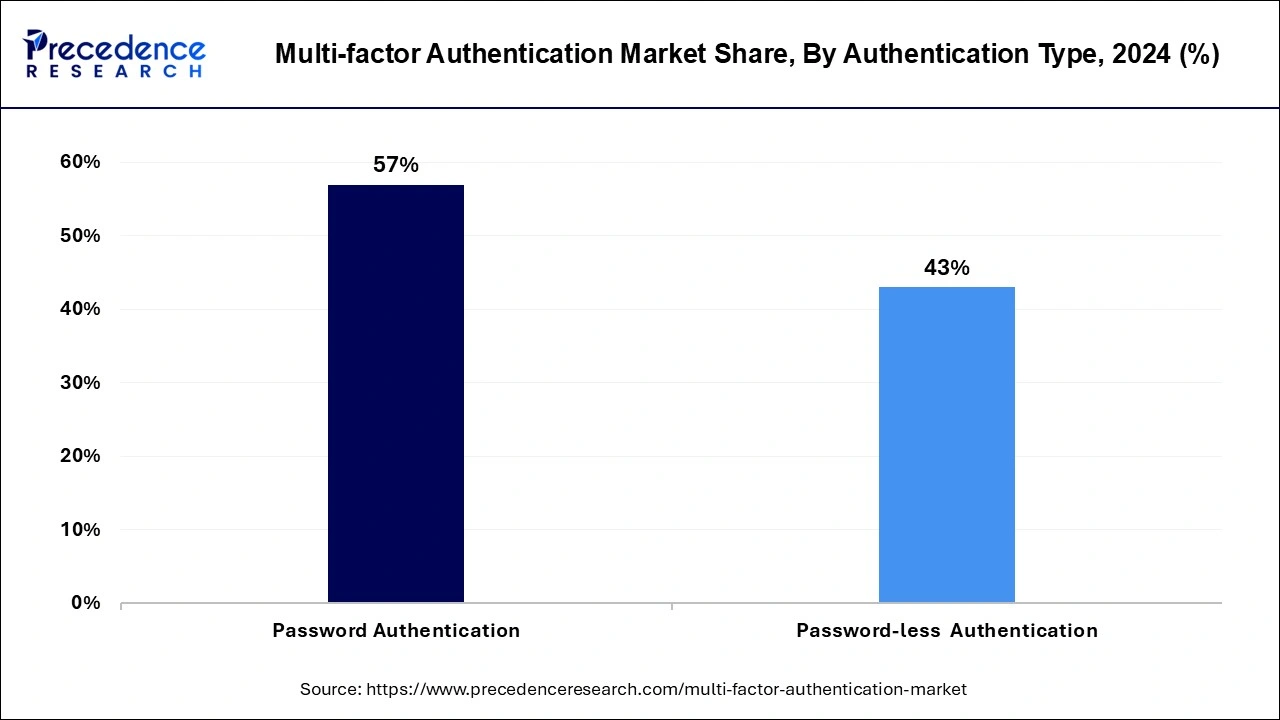
The password-less authentication segment is anticipated to witness rapid growth at a significant CAGR of 19.16% during the projected period. Password-less authentication is a segment within the multi-factor authentication (MFA) market that eliminates traditional password reliance. Instead, it employs methods like biometrics, security keys, or mobile-based authenticators. This approach enhances security by reducing the risk of password-related vulnerabilities. Growing concerns about password weaknesses and the push for user-friendly experiences drive the trend toward password-less authentication. Businesses are adopting this method to enhance security while simplifying user access, reflecting a broader industry shift towards more advanced and convenient authentication practices.
Model Type Insights
The multi-factor with three-factor authentication segment has held a 29% market share in 2024. In the multi-factor authentication market, the three-factor authentication segment involves verifying identity using three distinct authentication factors. These factors typically include something the user knows (like a password), something the user has (such as a security token), and something the user is (like a fingerprint). The trend in this segment reflects a growing emphasis on heightened security measures, aligning with the increasing awareness of the limitations of two-factor authentication. Organizations are adopting three-factor authentication to enhance protection against evolving cyber threats.
The multi-factor with four-factor authentication segment is anticipated to witness rapid growth over the projected period. In the multi-factor authentication (MFA) market, the four-factor authentication segment involves using four distinct methods for user verification. These typically include something the user knows (password), something the user has (smart card or mobile device), something the user is (biometric data), and somewhere the user is located (geographical location). This approach enhances security by requiring multiple forms of verification. The trend in this segment indicates a growing preference for comprehensive authentication solutions, emphasizing heightened security measures to combat evolving cyber threats.
Component Insights
The hardware segment has held a 45% market share in 2024. In the multi-factor authentication (MFA) market, the hardware segment refers to physical devices used for authentication, such as security tokens, smart cards, and biometric scanners. These devices provide an additional layer of security beyond passwords. A notable trend in this segment is the advancement of biometric hardware, including fingerprint and facial recognition sensors, enhancing both security and user convenience. The hardware component continues to evolve, offering durable and sophisticated solutions to meet the increasing demand for secure authentication in various industries.
The services segment is anticipated to witness the fastest growth over the projected period. In the multi-factor authentication (MFA) market, the "services" segment encompasses various offerings such as consulting, implementation, training, and support. Service providers assist organizations in deploying and managing MFA solutions effectively. A notable trend in this segment is the increasing demand for MFA consulting services, where experts guide businesses in choosing, implementing, and optimizing MFA solutions based on their specific needs. As MFA adoption continues to grow, the services segment plays a vital role in ensuring seamless integration and ongoing support for robust authentication practices.
End User Insights
The commercial security segment has held a 26% market share in 2024. The commercial security segment in the multi-factor authentication (MFA) market refers to businesses and enterprises utilizing MFA to enhance access controls. A notable trend in this segment involves the integration of biometrics, such as fingerprint recognition and facial scanning, to bolster security. Additionally, the adoption of cloud-based MFA solutions is rising among commercial entities, providing flexible and scalable authentication options. As businesses prioritize robust security measures, the commercial security segment continues to drive the evolution of MFA technologies to safeguard sensitive information and assets.
The telecommunication segment is anticipated to witness rapid growth over the projected period. In the multi-factor authentication market, the telecommunication segment refers to companies within the telecommunications industry that deploy MFA solutions. With the increasing prevalence of cyber threats, telecom providers are adopting MFA to secure sensitive customer data and protect against unauthorized access. The trend in this segment involves the integration of advanced authentication methods, such as biometrics and mobile-based solutions, to enhance security measures. This ensures that telecommunications companies can safeguard their networks and customer information in the face of evolving cyber risks.
Multi-factor Authentication Market Companies
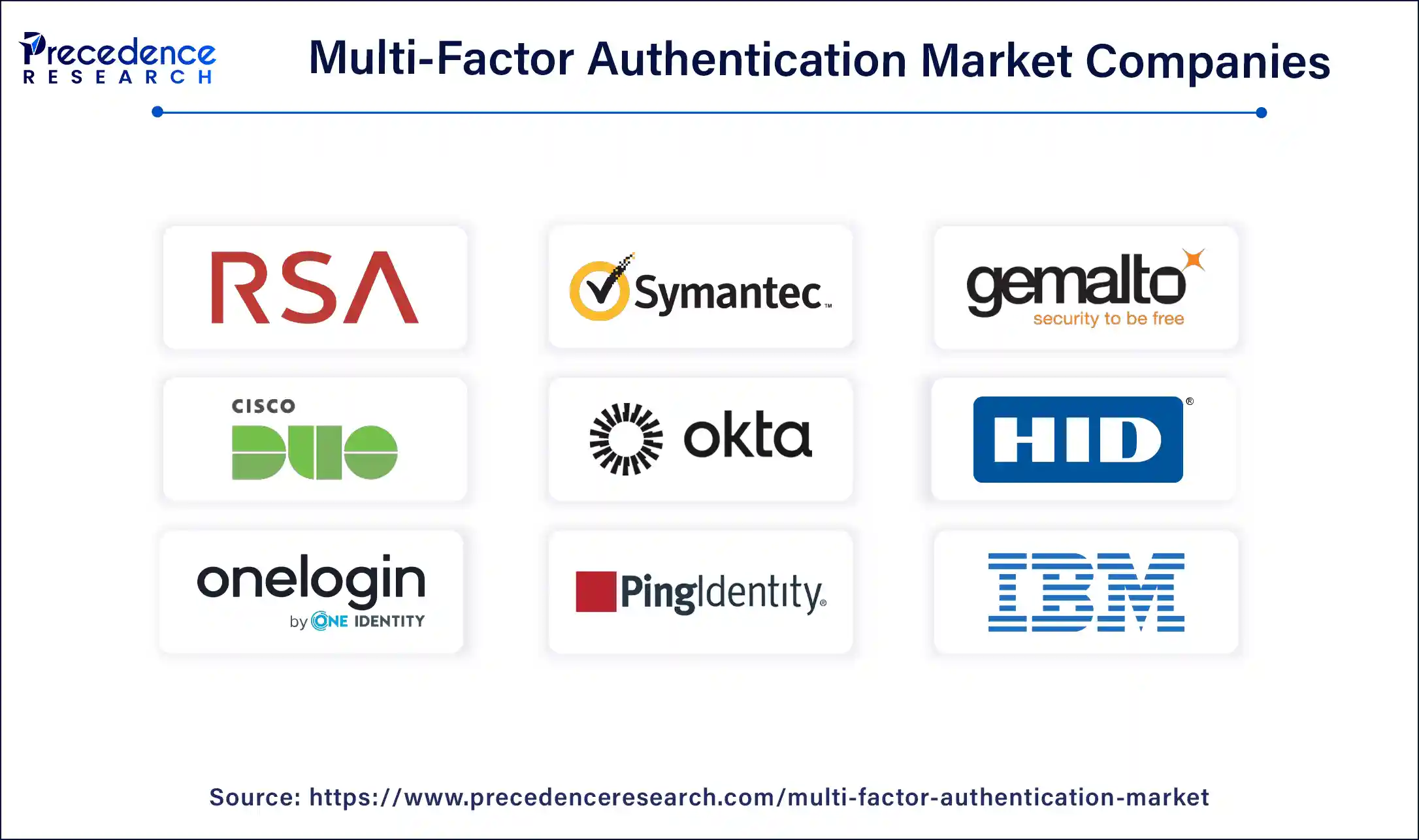
- RSA Security
- Symantec Corporation
- Gemalto (Thales Group)
- Duo Security (Cisco)
- Okta, Inc.
- HID Global
- OneLogin, Inc.
- Ping Identity
- IBM Corporation
- Microsoft Corporation
- Entrust Datacard Corporation
- Authy Inc.
- NEC Corporation
- CyberArk Software Ltd.
- SecureAuth Corporation
Latest Announcement by Industry Leader
- In October 2024, Microsoft announced plans to bolster security for Entra tenants by mandating multifactor authentication (MFA) registration for users under security defaults. The company is eliminating the 14-day grace period previously allowed users to skip MFA registration. According to Microsoft's Nitika Gupta, this change means all users will be required to complete their MFA setup during their first login once security defaults are activated. This policy aims to significantly enhance account protection, as Microsoft notes that MFA can block over 99.2% of identity-based attacks. By prioritizing MFA registration, Microsoft seeks to reduce the risks associated with identity compromise and strengthen overall security for Entra users.
Recent Developments
- In January 2025, BIO-key International, Inc., a leading provider of Identity and Access Management (IAM) solutions specializing in multi-factor authentication (MFA) and Single Sign-On (SSO) technologies, announced that the National Bank of Egypt (NBE), the country's largest financial institution, has adopted BIO-key's PortalGuard IAM platform. This deployment, undertaken in partnership with Raya Information Technology, a certified reseller of BIO-key solutions, aligns with NBE's commitment to integrating best-in-class IT solutions for its workforce of 30,000 employees.
- In March 2024, Identiv, Inc., a global leader in digital security and IoT identification solutions, introduced ScrambleFactor, a cutting-edge addition to its high-security physical access control system (PACS) portfolio. The ScrambleFactor reader revolutionizes secure entry for the federal market by integrating fingerprint biometrics with an advanced LCD touchscreen keypad, enabling multiple authentication methods to deliver unmatched security, speed, and convenience.
- In February 2024, Entersekt, a pioneer in financial authentication, continued its innovation against financial fraud by securing its 99th software technology patent, granted by the U.S. Patent Office. This new patent, titled "Frictionless SCA," highlights Entersekt's ability to deliver seamless multi-factor authentication without requiring explicit user interaction. This advancement solidifies Entersekt's position as a leader in developing cutting-edge, frictionless security solutions.
Segments Covered in the Report
By Authentication Type
- Password authentication
- Password less authentication
By Model Type
- Smart card with pin
- Multi-factor with three-factor authentication
- Multi-factor with four-factor authentication
- Multi-factor with five-factor authentication
By Component
- Solutions
- Hardware
- Services
By End User
- BFSI
- Government
- Travel and Immigration
- Military and Defense
- Commercial Security
- IT
- Telecommunication
- Healthcare
- Media and Entertainment
- Other
By Geography
- North America
- Europe
- Asia-Pacific
- Latin America
- Middle East and Africa
For inquiries regarding discounts, bulk purchases, or customization requests, please contact us at sales@precedenceresearch.com
Frequently Asked Questions
Ask For Sample
No cookie-cutter, only authentic analysis – take the 1st step to become a Precedence Research client
 sales@precedenceresearch.com
sales@precedenceresearch.com
 +1 804-441-9344
+1 804-441-9344